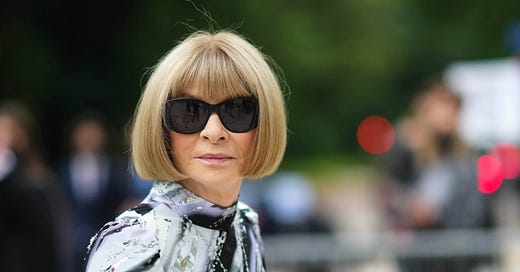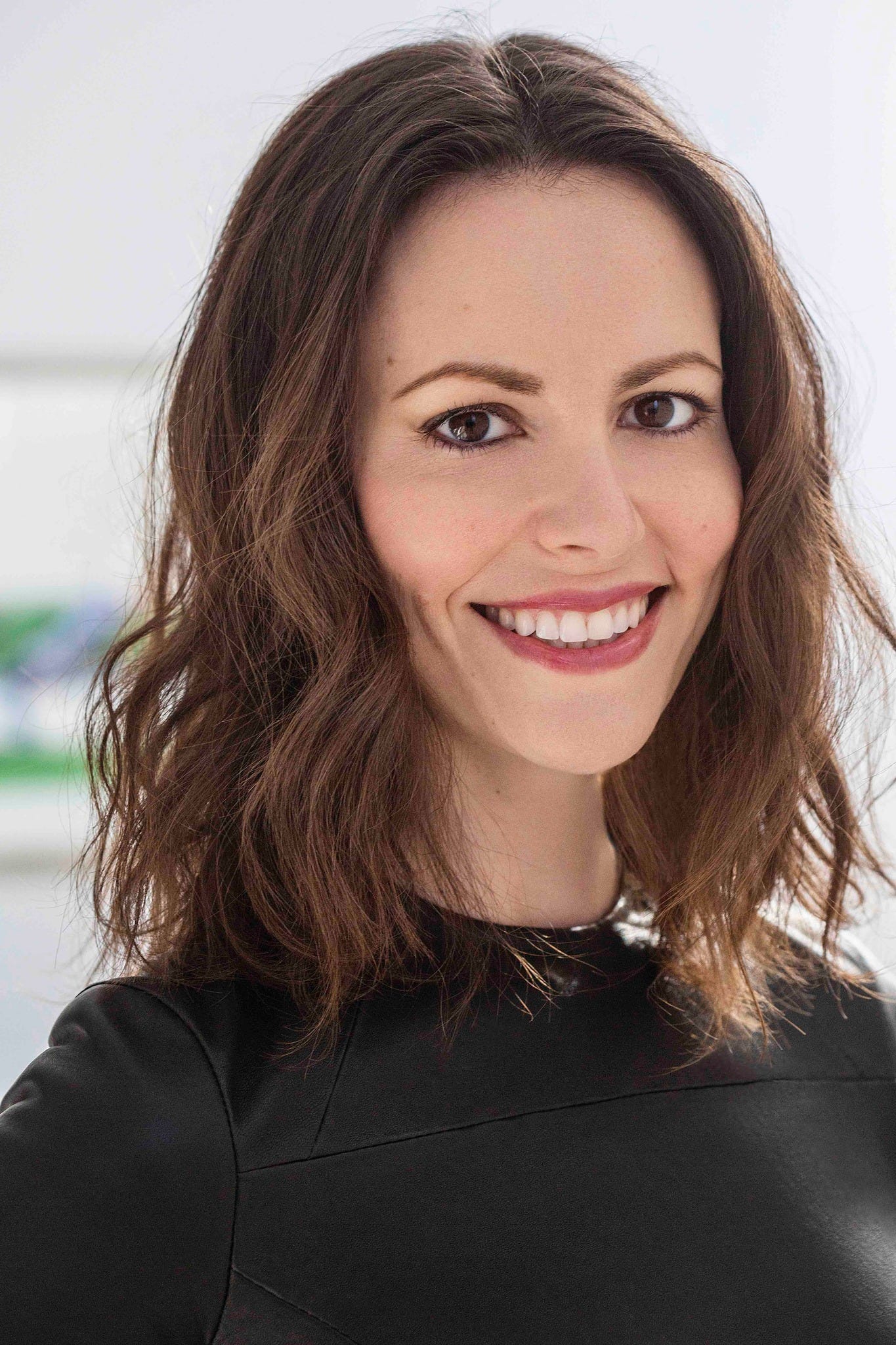What Makes Anna Wintour So Powerful?
As the Met Gala nears, my chat with the author of a new biography of the feared fashion editor.
Welcome to So Many Thoughts, a semi-weekly newsletter about royal style and the other parts of life I want to think through with you. You can subscribe here and follow me on Instagram at @EHolmes. Thank you!
The countdown is on for Monday’s Met Gala, which Vogue bills as “the fashion world equivalent of the Oscars.” Anna Wintour, editor-in-chief of the celebrated fashion magazine as well as chief content officer of its parent company Condé Nast, has been the mastermind behind the annual event for more than two decades.
My primer on the Met Gala is coming Sunday (stay tuned!), but first some background on the influential yet elusive editor who grew the event from a society dinner to the biggest night in American fashion. Below you’ll find my interview with Amy Odell, the fashion journalist behind the new biography, ANNA.
And mark your calendars! I’ll be going live on Instagram with Amy on Monday, May 2 at 12pm PT / 3pm ET, just before the Met carpet kicks off. Join us with all of your burning Anna questions.
What do you think of Anna Wintour? Hit the button below and let me know your thoughts in the comments of this newsletter.
Decoding Anna
When I saw the news that fashion and culture journalist Amy Odell, a friend of mine from our days attending fashion week, was writing a biography of Anna Wintour, I audibly gasped. And when an advanced copy of the book arrived, I dove right in. Friends, this is a BOOK. Amy has traced the feared fashion editor back to her very beginnings, telling her story in fascinating detail.
ANNA is out next Tuesday; pre-order your copy today on Amazon, Bookshop, or wherever you get your books.
I caught up with Amy recently to ask about the project (and the burning question of whether Anna herself was involved), which got me thinking about the ways in which Anna is like the Queen. Our chat, lightly edited and condensed, covers everything from Anna’s sunglasses to why chives aren’t allowed at Met Gala meals.
Why did you want to write a biography of Anna Wintour?
Amy Odell: I have long been fascinated by Anna Wintour — I'm not unique in that. She has been at the helm of Vogue for 34 years. It is one thing to be successful. It is another thing to be as successful as she has been for a very long time. So that really is the genesis of the book. What has made her so powerful? And how has she held onto that power for so long?
Despite being in this public position for so long, she remains an enigma even to people who know her. This book really aims to pull back the curtain on who she really is.
And who is she? Did you reach a conclusion?
AO: Many people will know Meryl Streep’s depiction of her in The Devil Wears Prada. But that character is a caricature. It’s a one-dimensional view of a woman who is complicated. That’s a word that many people used over and over again, independently of one another: She’s complicated.
Some things about that depiction are real. She can be cold, she can be icy. If you become radioactive to her, she can drop you from her life and never talk to you again. However, she has a warm and loving life at home with her family. She is a grandmother who changes diapers. She loves her dogs. And this duality of her has never before been explored.
What did Anna have to say about this project? Did you interview her for the book?
AO: When I approached people for interviews, I got one of two responses. One was: She’s going to throw all the might of Condé Nast behind shutting this project down; good luck, this is going to get ugly for you. The other group of people said, I’m sure she’ll help you. That just points to the enigma that she is.
But what ultimately happened was, after her office found out I was working on the book, her representatives came back and said, “Anna would like to set you up with her closest friends and colleagues for interviews.” The list included people like Tom Ford and Serena Williams, who I spoke to for the book. Anna herself was not interviewed. But the fact that she put all these people forward, it did seem like she was trying to help it along.
How much of her success is attributable to her and how much to the people she has worked with, like André Leon Talley?
AO: I think it’s a combination of both. She’s very good at cutting through bullshit and operating in a corporate environment that is Conde Nast. She was also a fashion editor for a long time — she loves creative people and she understands the creative process. So she can really merge those two sides of a magazine, the creative side and the business.
What is Anna without Vogue?
AO: You don’t need Vogue to know what's going on in fashion. Anybody can go on social media or look at runway shows. You can see what people are wearing on TikTok.
But if Vogue disappeared tomorrow, she’s someone who would have influence and power. Because what I learned is behind the scenes people are asking her advice on all kinds of things. I was kind of floored honestly, to hear that Bradley Cooper sent her script for A Star is Born. Hugh Jackman, too — there’s a scene in the book about the Vogue staff going to a room at Soho house to discuss The Greatest Showman with Hugh Jackman before that movie was made. She has also raised a lot of money for Barack Obama and for Hillary Clinton. She advised Hillary Clinton on her fashion choices when she was First Lady.
It’s not something that Anna talks about because Anna doesn’t talk about what she's doing. But that is probably the biggest reason that she remains powerful and influential.
That aspect of her reminds me of the royal family. They don’t talk much, but they appear often. And Anna has quite an appearance. Why does she wear sunglasses?
AO: The sunglasses are actually prescription; she doesn’t have great eyesight. People close to her said that she prefers the appearance of sunglasses. She’s worn those sunglasses since she was young and also the bob hair, which she got when she was a teenager. It’s an example of her decisiveness, her laser focus, and commitment to things.
She did the same thing with Vogue. The look of the magazine has evolved, but if you find older covers of Vogue, there’s a formula. It’s happy, smiling, gardens, sunlight, colorful dresses. It's almost a cliche; we became so accustomed to it for so long. That's how she is. She has an idea, it works for her, and she can execute on it again and again.
Does she seek input, personally or professionally, from anyone?
AO: I was so fortunate to be able to speak with André Leon Talley before he died. We talked for hours. He was almost Anna’s unofficial wardrobe advisor. He would go with her to Chanel couture fittings — she wanted his opinion on what she was wearing. So even though she had this formula, things that work for her, she was still seeking at least his opinion on the exact choices she was making within the formula.
The Met Gala is coming up on Monday. What does the annual fundraiser mean to Anna?
AO: Anna wants her legacy to be around her philanthropic work, not around the work that she’s done as a magazine editor. She’s raised money for a lot of causes over the years, including AIDS, youth, mental health, breast cancer. The biggest is probably The Metropolitan Museum of Art Costume Institute, and that's what the gala is designed to raise money for.
Those high, high ticket prices that you read about — $30,000 to $35,000 a ticket — are going to fund the Costume Institute. Anna has grown it to be able to charge that amount of money through militant control. “Militant” is a word that Stephanie Winston Wolkoff, who planned the gala for more than 10 years, used in an interview with me. Anna has insane attention to detail, really. For years, she did not want garlic, chives, parsley, or onions in the food because they make your breath smell and get stuck in your teeth. Through this management, she did grow it from kind of a sleepy New York society event to an internationally recognized red carpet that celebrities are clamoring to get into.
I am surprised she has held on this long, especially after that 2020 piece in the New York Times with the headline, “Can Anna Wintour Survive the Social Justice Movement?” Has her time, or her approach, passed?
AO: If you look at Vogue covers from 1988, when she took over, to today, you can see whether or not diversity has been a priority to her. That changed around the summer of 2020, the covers did become more diverse. But I think that readers of the book should think about that for themselves: Is it too little too late? Or is it enough that she made these changes?
What I can say is that she does seem to be serving an important function at Condé Nast, which is to make money for the company. People told me that she could call an advertiser and say, “We’re disappointed to hear that you're not supporting us.” And then they’ll keep their ads in the magazine instead of pulling them. That makes her valuable to the company.
There was no indication in my reporting that she is thinking about leaving the job anytime soon. I really think she loves it. I think she loves this work and she’s not just going to give it up because a bunch of other people think that she should.
But she’s 72 years old. She can’t have the job forever.
Pre-order your copy of ANNA today wherever you get your books or look for it on store shelves when it comes out Tuesday, May 3.
Have Thoughts to share? I’d love to hear them! Hit the button below to leave a comment. You can also send me an email at hello@somanythoughts.com.
It would mean so much if you would forward this newsletter to a friend. You can subscribe to So Many Thoughts here, follow the fun on Instagram at @EHolmes, and check out my New York Times bestseller, HRH: So Many Thoughts on Royal Style. Thank you for supporting my work!







